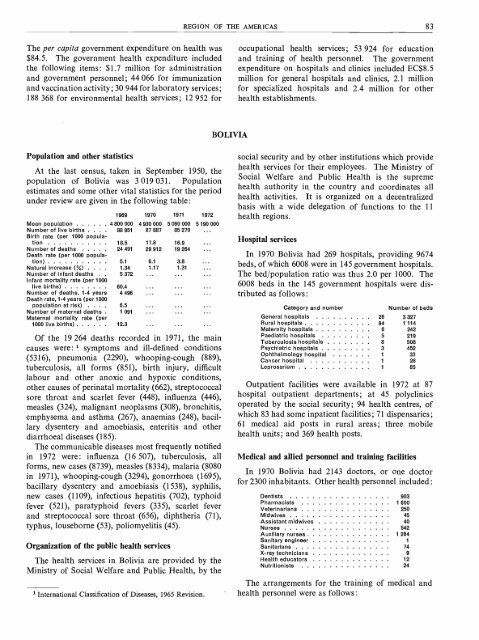FIFTH REPORT - World Health Organization
FIFTH REPORT - World Health Organization
FIFTH REPORT - World Health Organization
You also want an ePaper? Increase the reach of your titles
YUMPU automatically turns print PDFs into web optimized ePapers that Google loves.
REGION OF THE AMERICAS 83<br />
The per capita government expenditure on health was<br />
$84.5. The government health expenditure included<br />
the following items: $1.7 million for administration<br />
and government personnel; 44 066 for immunization<br />
and vaccination activity; 30 944 for laboratory services;<br />
188 368 for environmental health services; 12 952 for<br />
occupational health services; 53 924 for education<br />
and training of health personnel. The government<br />
expenditure on hospitals and clinics included EC$8.5<br />
million for general hospitals and clinics, 2.1 million<br />
for specialized hospitals and 2.4 million for other<br />
health establishments.<br />
BOLIVIA<br />
Population and other statistics<br />
At the last census, taken in September 1950, the<br />
population of Bolivia was 3 019 031. Population<br />
estimates and some other vital statistics for the period<br />
under review are given in the following table :<br />
1969 1970 1971 1972<br />
Mean population 4 800 000 4 930 000 5 060 000 5 190 000<br />
Number of live births . 88951 87 887 85 270 ...<br />
Birth rate (per 1000 population<br />
18.5 17.8 16.9<br />
Number of deaths 24491 29912 19264<br />
Death rate (per 1000 population)<br />
5.1 6.1 3.8<br />
Natural increase (%) . . . . 1.34 1.17 1.31<br />
Number of infant deaths . 5 372<br />
Infant mortality rate (per 1000<br />
live births) 60.4<br />
Number of deaths, 1 -4 years 4496<br />
Death rate, 1 -4 years (per 1000<br />
population at risk) 6.5<br />
Number of maternal deaths 1 091<br />
rate<br />
1000 live births) 12.3<br />
Of the 19 264 deaths recorded in 1971, the main<br />
causes were :1 symptoms and ill- defined conditions<br />
(5316), pneumonia (2290), whooping -cough (889),<br />
tuberculosis, all forms (851), birth injury, difficult<br />
labour and other anoxic and hypoxic conditions,<br />
other causes of perinatal mortality (662), streptococcal<br />
sore throat and scarlet fever (448), influenza (446),<br />
measles (324), malignant neoplasms (308), bronchitis,<br />
emphysema and asthma (267), anaemias (248), bacillary<br />
dysentery and amoebiasis, enteritis and other<br />
diarrhoeal diseases (185).<br />
The communicable diseases most frequently notified<br />
in 1972 were: influenza (16 507), tuberculosis, all<br />
forms, new cases (8739), measles (8334), malaria (8080<br />
in 1971), whooping -cough (3294), gonorrhoea (1695),<br />
bacillary dysentery and amoebiasis (1538), syphilis,<br />
new cases (1109), infectious hepatitis (702), typhoid<br />
fever (521), paratyphoid fevers (335), scarlet fever<br />
and streptococcal sore throat (656), diphtheria (71),<br />
typhus, louseborne (53), poliomyelitis (45).<br />
<strong>Organization</strong> of the public health services<br />
The health services in Bolivia are provided by the<br />
Ministry of Social Welfare and Public <strong>Health</strong>, by the<br />
1 International Classification of Diseases, 1965 Revision.<br />
social security and by other institutions which provide<br />
health services for their employees. The Ministry of<br />
Social Welfare and Public <strong>Health</strong> is the supreme<br />
health authority in the country and coordinates all<br />
health activities. It is organized on a decentralized<br />
basis with a wide delegation of functions to the 11<br />
health regions.<br />
Hospital services<br />
In 1970 Bolivia had 269 hospitals, providing 9674<br />
beds, of which 6008 were in 145 government hospitals.<br />
The bed /population ratio was thus 2.0 per 1000. The<br />
6008 beds in the 145 government hospitals were distributed<br />
as follows:<br />
Category and number<br />
Number of beds<br />
General hospitals 26 3 327<br />
Rural hospitals 94 1 114<br />
Maternity hospitals 6 242<br />
Paediatric hospitals 5 219<br />
Tuberculosis hospitals 8 508<br />
Psychiatric hospitals 3 452<br />
Ophthalmology hospital 1 33<br />
Cancer hospital 1 28<br />
Leprosarium 1 85<br />
Outpatient facilities were available in 1972 at 87<br />
hospital outpatient departments; at 45 polyclinics<br />
operated by the social security; 94 health centres, of<br />
which 83 had some inpatient facilities; 71 dispensaries;<br />
61 medical aid posts in rural areas; three mobile<br />
health units; and 369 health posts.<br />
Medical and allied personnel and training facilities<br />
In 1970 Bolivia had 2143 doctors, or one doctor<br />
for 2300 inhabitants. Other health personnel included:<br />
Dentists 903<br />
Pharmacists 1 600<br />
Veterinarians 250<br />
Midwives 45<br />
Assistant midwives 40<br />
Nurses 542<br />
Auxiliary nurses 1 264<br />
Sanitary engineer 1<br />
Sanitarlans 74<br />
X -ray technicians 9<br />
<strong>Health</strong> educators 12<br />
Nutritionists 24<br />
The arrangements for the training of medical and<br />
health personnel were as follows:
















